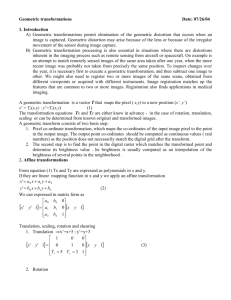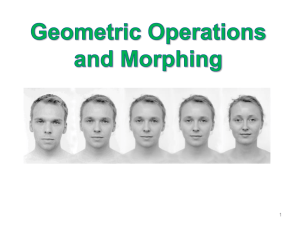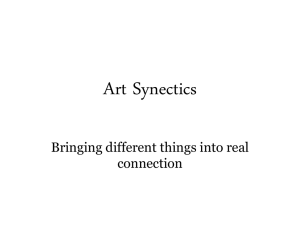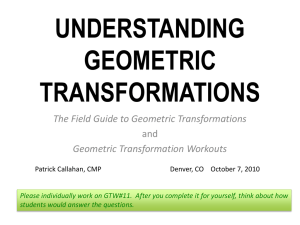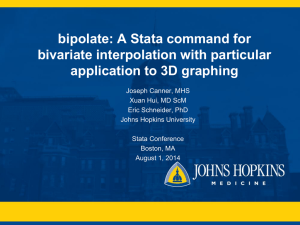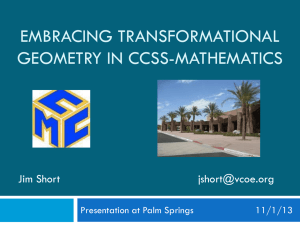L10-geometric
advertisement
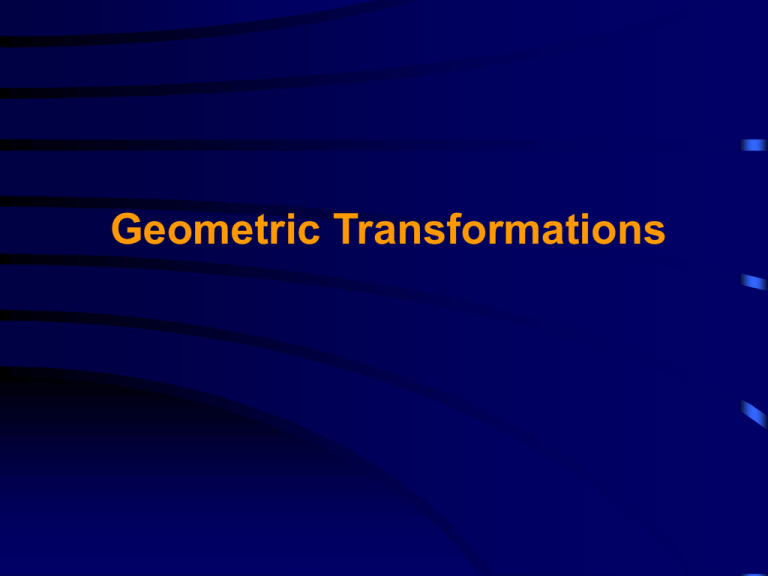
Geometric Transformations Geometric Transformations consist of two basic operations: (1) a spatial transformation - defines the “rearrangement” of pixels on the image plane (2) a grey-level interpolation method determines the assignment of intensity values to pixels in the spatially transformed image Geometric Transformations - scaling - rotation - translation - perspective transformations - image registration - warping / morphing Interpolation Methods: - nearest neighbor - bilinear interpolation - cubic B-spline Interpolation Methods: NEAREST NEIGHBOR (zero-order interpolation) : assigns pixel value to that of nearest neighbor advantages: - simple and efficient implementation - enables image zooming disadvantages: - may produce distortion of edges - undesirable sawtooth artifacts (jaggies) Interpolation Methods: BILINEAR INTERPOLATION (first-order interpolation) assigns pixel value as a weighted interpolation of the values of its four defined neighbors advantages: - relatively simple and efficient - produces more desirable (smoother) results than nearest neighbor disadvantages: - derivatives of piecewise bilinear surfaces are discontinuous at neighborhood boundaries Interpolation Methods: CUBIC B-SPLINE (third-order interpolation) : assigns pixel value as a weighted interpolation of the values of a larger set of defined neighbors advantages: - produces most desirable (smoothest) results disadvantages: - computationally costly Geometric Transformations: Example SCALING (1) a spatial transformation: X’= S X, X Y ’= S Y y (2) a grey-level interpolation method nearest neighbor (pixel replication) bilinear interpolation (average of 4 neighbors) cubic b-spline Geometric Transformations: SCALING When Sx = Sy = 2k, all three methods of grey level interpolation may be performed by 1) inserting zero values into image for every other row and every other column 2) performing a convolution with the proper convolution kernel Nearest neighbor * 2X 1 1 1 1 Nearest neighbor 4X Bilinear Interpolation 1 * 2X 4 1 2 1 2 4 2 1 2 1 Bilinear Interpolation 4X Cubic B-Spline * 1 64 2X 1 4 6 4 1 4 16 24 16 4 6 24 36 24 6 4 16 24 16 4 1 4 6 4 1 Cubic B-Spline 4X Nearest Neighbor Bilinear Interpolation Bilinear Interpolation Bi-cubic Spline Interpolation Geometric Transformations: SCALING When Sx = Sy = 2k, the computation of pixel values for the new image is more complex. Two different schemes are possible for mapping pixel locations from the source image to pixel locations within the new resized image 1) Source-to-target mapping 2) Target-to-source mapping Geometric Transformations: SCALING When Sx = Sy = 2k, the computation of pixel values for the new image is more complex. 1) Source-to-target mapping X ’ = SX X, Y ’= S y Y Using this mapping certain pixels in the new image will have nothing mapped to it. Geometric Transformations: SCALING X ’ = S X, Y ’= S Y X y With a scaling factor Sx=3, Sy=3 pixel(3,5) -> newpixel(9,15) pixel(4,5) -> newpixel(12,15) 2 3 4 5 6 7 7 4 14 5 15 6 16 7 17 8 18 9 19 8 9 10 11 12 Geometric Transformations: SCALING X ’ = S X, Y ’= S Y X y With a source-to-target mapping how does newpixel(10,15) get its value? 2 3 4 5 6 7 7 4 14 5 15 6 16 7 17 8 18 9 19 8 9 10 11 12 Geometric Transformations: SCALING When Sx = Sy = 2k, the computation of pixel values for the new image is more complex. 1) Source-to-target mapping X ’ = SX X, Y ’= S y Y 2) Target-to-source mapping X = X’/ SX , Y = Y’/ S y Geometric Transformations: SCALING X = X’/ S , Y = Y’/ S y X With a scaling factor Sx=3, Sy=3 newpixel(9,15) -> pixel(3,5) newpixel(10,15) -> pixel(3.3,5) 2 3 4 5 6 7 7 4 14 5 15 6 16 7 17 8 18 9 19 8 9 10 11 12 Geometric Transformations: SCALING newpixel(10,15) -> pixel(3.3,5) 2 4 5 6 7 8 9 3 4 5 6 7 ?? 1) nearest neighbor round the x,y values and take the new pixel value from that location in the source image 2) bilinear interpolation compute the new pixel value as a weighted average of the neighboring pixels in the source image Geometric Transformations - scaling - rotation - translation - perspective transformations - image registration - warping / morphing perspective transformations perspective transformations Tie points are identified in each image to compute a transformation matrix which can be used to compute remapping locations in the new image perspective transformations Calibration images can be used to automate tie point identification
